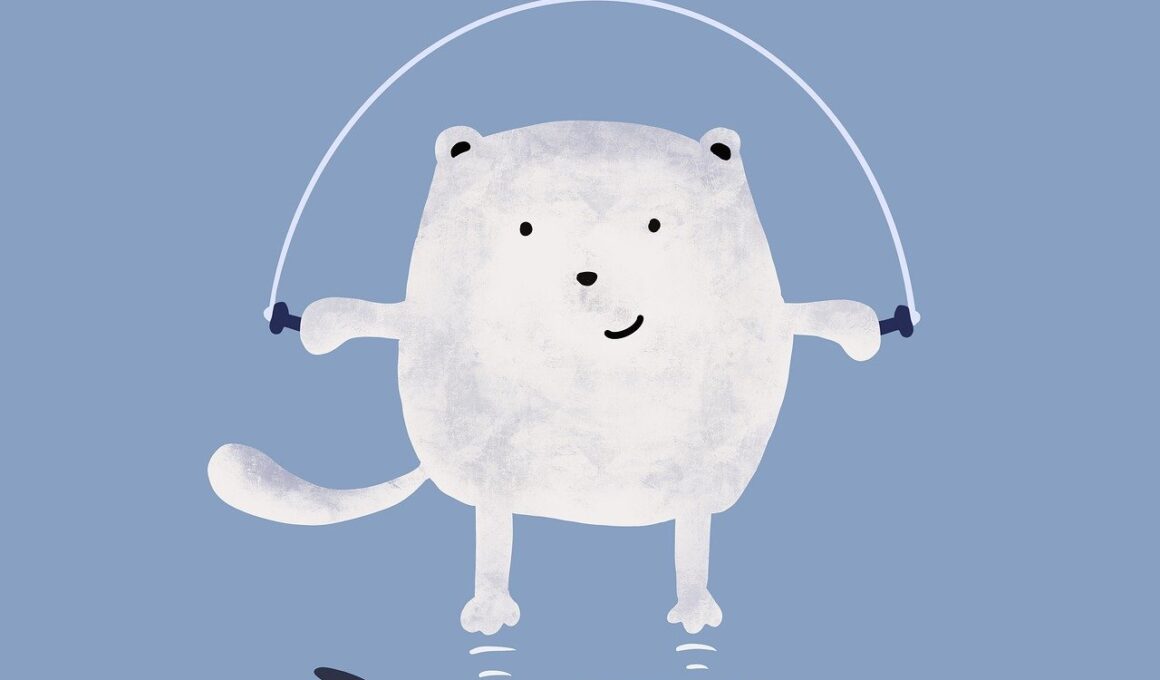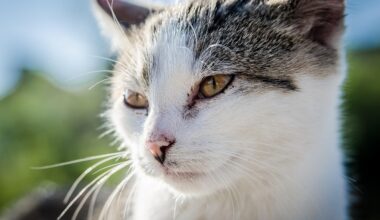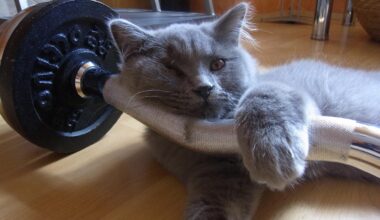Health Risks of Obesity and How Exercise Can Help Cats
Obesity is a significant health concern for cats, leading to numerous complications. Cats, like humans, can suffer from various health issues due to excessive weight. The added weight can place excessive stress on joints, leading to conditions such as arthritis. This discomfort can affect their mobility and, consequently, their quality of life. Additionally, obesity can predispose cats to diabetes, a serious condition requiring ongoing management. As insulin sensitivity decreases, managing blood sugar levels becomes increasingly difficult without proper diet and exercise. Furthermore, an overweight cat may face respiratory difficulties, which can have significant implications for overall health. Obesity can also lead to hepatic lipidosis, a severe liver condition occurring when cats rapidly lose weight after being overweight for a long time. Given these serious health risks, maintaining a healthy weight is crucial for your feline friend’s longevity and quality of life. Exercise plays a pivotal role in regulating a cat’s weight, reducing the likelihood of developing these dangerous diseases. Regular activity supports not only the physical health of cats but also promotes mental stimulation, which is equally essential for their well-being.
Exercise is an integral component to prevent and manage obesity in cats. Regular physical activity aids in burning off excess calories, allowing cats to maintain a healthy body weight. Engaging your cat in playful activities not only promotes weight management but also fosters a strong bond between pet and owner. Varied activities, such as using feather toys or interactive laser pointers, can significantly motivate cats to be active. Creating an enriching environment can facilitate exercise; ensure your home offers different climbing surfaces and hiding spots. Cats, as natural hunters, thrive on engaging stimuli that mimic their instinctual behaviors. Incorporating playtime into your cat’s daily routine will also help reduce boredom and associated behavioral issues. An active cat is a happy cat, and exercise can significantly elevate their mood and decrease stress. Additionally, consider scheduling regular vet check-ups to monitor their weight and overall health. A veterinarian can offer tailored advice on suitable exercise routines for your cat’s specific needs. Making fitness a fun and regular part of your cat’s life can transform their health in the long-term, ensuring they remain active and vibrant companions.
Understanding Cat Nutrition
Besides exercise, proper nutrition is vital in managing a cat’s weight and overall health. Many cat owners may overlook the importance of a balanced diet. The balance between calorie intake and expenditure is critical in maintaining a healthy weight. High-calorie diets can quickly contribute to weight gain, especially without adequate exercise. Always consult with a veterinarian to select the appropriate food for your cat’s age, size, and activity level. It’s vital to read labels and avoid foods high in fillers, which provide minimal nutritional value. Instead, look for high-quality proteins and healthy fats to support their energy levels and general health. Besides examining the food itself, it’s essential to control portion sizes. Measure your cat’s food portions carefully to avoid overfeeding. Feeding smaller, more frequent meals can simulate a more natural eating behavior akin to their wild ancestors, promoting a healthier metabolism. Additionally, avoid free-feeding to help maintain control over your cat’s calorie consumption. Make it a practice to provide fresh water regularly, as hydration is key to their health. Monitor their weight frequently, adjusting their diet and activity levels as necessary to maintain a healthy balance.
Incorporating outdoor activities can also be beneficial for weight management in cats. Letting your cat enjoy the fresh air can increase their physical activity levels significantly. Cat owners can take their cats outdoors on harnesses or within enclosed catios. This experience can satisfy a cat’s curiosity and provide mental stimulation. Supervised outdoor time allows cats to explore their environment safely while staying active. Try setting up obstacle courses in your backyard or nearby cat-friendly areas to enhance their physical exertion. Besides increasing fitness levels, outdoor exploration can pique their natural hunting instincts, a vital aspect of their behavior. However, ensure that the outdoor environment is safe from hazards such as aggressive dogs or busy roads. Regularly monitor your cat’s interaction with the outdoors, ensuring the experience is enjoyable and stress-free. Additionally, always remember that certain breeds have different preferences and tolerances towards outdoor activities. Growing a safe space for your cat also promotes bonding time as you interact and engage with them in meaningful activities that are fun and healthy.
Establishing a Routine
Creating a consistent exercise routine is essential for cats. Just like humans benefit from structured fitness schedules, cats thrive when they understand when to expect playtime. Aim for short yet regular sessions throughout the day, instead of occasional long periods. Cats are typically more energetic in the early morning or evening, aligning with their natural instincts. Take advantage of these peak activity times to engage your feline friend with lively activities. Include varied forms of play to keep them interested and motivated over time. Rotate toys frequently to maintain excitement — sometimes a simple box can spark joy and curiosity! Regular play strengthens your bond and provides much-needed physical and mental stimulation, which makes exercising feel like a fun activity rather than a chore. Furthermore, involving family members in this playful routine can encourage everyone to participate, especially children, who may discover the joy of interacting with a pet. Tracking your cat’s physical activity, perhaps using simple logs, can provide insights into their progress and help adjust the routine as necessary to suit evolving needs.
Understanding your cat’s mental stimulation alongside physical exercise is crucial. Boredom can lead to sluggishness and, eventually, an unhealthy weight. Cats need mental challenges to stay engaged and active. Puzzle feeders, for instance, can promote exercise by making them work for their food, combining playtime with mealtime. This approach not only will keep them active but also stimulates their natural hunting instincts, fulfilling a primary feline behavior. Additionally, engaging them with different toys, including wand toys or toys with various textures, can further enrich their environment. It’s essential to observe what captures your cat’s attention; every cat is different and has its unique preferences. Observing these preferences lets owners provide tailored mental stimulation that promotes activity. Hiding treats around the house can also act as an enjoyable treasure hunt, encouraging movement while exploring different parts of their home. Maintaining a stimulating environment can deter the development of obesity by ensuring your feline friends remain enthusiastic and engaged without turning to inactivity or unhealthy eating habits. Make it a point to invest in their mental health just as you would their physical health, integrating both into their exercise regimen.
The Importance of Regular Vet Visits
Regular veterinary check-ups are vital in managing your cat’s health and weight. Weight management is not just about diet and exercise; veterinary guidance can significantly impact your cat’s overall well-being. Routine check-ups allow for early detection of potential health concerns associated with obesity, such as diabetes and thyroid issues. Your veterinarian can advise on a suitable weight goal for your cat based on their unique health considerations and breed. Follow-up check-ups verify if diet and exercise adjustments lead to healthy weight loss. Regular team evaluations ensure that any additional concerns or changes in health. This ongoing relationship with a vet acts as an accountability point for both you and your cat. It’s essential to track their weight, where minor fluctuations are normal but significant weight changes should be monitored and reported. Additionally, discussing any behavioral changes or dietary concerns during these visits helps personalize their weight management plan. By prioritizing preventive health care, you are investing in a longer and healthier life for your beloved feline companion. Because of this, maintaining your cat’s well-being becomes a team effort that includes you, your cat, and your veterinarian.
In conclusion, effectively managing a cat’s weight through exercise and nutrition is vital. The dangers associated with obesity can significantly deteriorate a cat’s quality of life, leading to severe health complications. Investing time in regular exercise contributes to a healthier cat overall. Owners should strive to create engaging and stimulating environments where cats can exercise freely. The key is keeping the activities varied and fun to ensure maximum engagement from your cat. Nutrition closely ties with exercise in maintaining a healthy weight. Choosing the right foods and maintaining proper portion sizes are essential for their well-being. Remember to consult with your veterinarian regularly to ensure all recommendations fit your cat’s individual needs. By prioritizing their health, you can enhance their quality of life and longevity. Cats thrive in environments where they can engage in regular, enjoyable activities that support their physical and mental health. Every little effort contributes to their happiness and well-being. Ultimately, an active lifestyle paired with suitable nutrition will foster a more vibrant life for your cat, allowing them to live to their fullest potential. Take action today, as your determination can set the tone for a healthier future.


